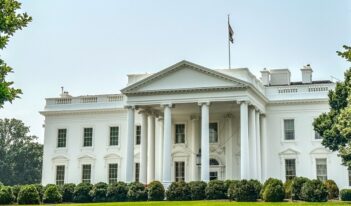
Practical obstacles to implementing policy illustrate how agencies assess their own constitutional authority.
Since 2017, the Trump Administration’s successive executive orders and administrative actions have relentlessly assaulted the asylum process, dismantled foundational refugee protections, and distorted the immigration admissions system. A new administration must address the damage inflicted on individuals, institutions, and the rule of law. Because legislation is only a remote possibility, reversing recent policies and restoring a semblance of integrity will depend on decisive and effective executive actions
This essay offers personal reflections on some of the bureaucratic barriers to achieving change that a new administration must anticipate—regardless of whether its most immediate efforts are merely “restorative” to return to the 2016 status quo ante or more ambitiously “reformative” to pursue new normative immigration policies. Although the threshold challenge for an administration is to determine its policies and priorities, the key to actually achieving meaningful reform will depend on the harder task of overcoming bureaucratic inertia and implementing new policies. That will be even more difficult than usual because of the norm-breaking practices of the current administration and the whiplash effect of reversing recently adopted measures.
I write based on my experience as a political appointee in the Obama Administration during the adoption of a series of immigration reform measures in 2014. For two years, I participated in the development and implementation of many of those reforms and in the day-to-day operation of the immigration adjudication apparatus as senior counselor to the Director of U.S. Citizenship and Immigration Services (USCIS) and then as the senior immigration counselor to the Secretary of Homeland Security. My background is atypical for someone in these positions. I spent most of my career litigating cases against federal immigration agencies as the founder and director of the ACLU Immigrants’ Rights Project, and I had neither the benefit nor the encumbrance of any prior executive branch experience. My discussion reflects on my experiences and elaborates on some of the real-world hurdles to implementing policy pronouncements, such as bureaucratic inertia, resistance to delegating discretion, cumbersome internal legal and policy processes, and the U.S. Department of Justice’s review of agency action.
Preference for Stasis. One embedded bureaucratic instinct I encountered firsthand is the well-known resistance to change, or perhaps more accurately preference for stasis. Although this might be explained by adherence to predictability, I experienced it as driven more by the entrenchment of the status quo independent of any purported normative values—at least when the proposed changes were designed to move in a more immigrant-friendly direction.
An especially revealing experience arose from efforts to modify a categorical disqualifying factor in the adjudication of certain immigration benefits. The goal was to dial back just slightly a new ground for disqualification and to authorize adjudicators to exercise case-by-case discretion based on individual circumstances. After considerable intra-departmental discussion, I presented a proposed consensus approach to senior career managers. To my surprise, they opposed the change despite their earlier reported opposition to adopting the disqualification in the first place. I asked if they had supported the bar that we now proposed softening, thinking naïvely that confronting them with their own earlier views might diminish their current opposition. But that was not the case. “Oh no,” said one. Instead, the rule “was wrong to begin with and a big mistake when it was adopted. But now that it’s the rule, we don’t want to change it.”
The preference for the status quo could be motivated by the burden of implementing changes, the risk of never-settled policy, the instinct that future cases should not be treated differently than those already completed, a general opposition to expansion of discretion, and perhaps a shift in normative preferences. But whatever the reason, a new administration intending to reverse recent policies must anticipate substantial bureaucratic resistance to abandoning any entrenched practices, no matter how recently adopted, and even if the career civil servants themselves strongly objected to adoption of the recent policies in the first place.
Resistance to Broad Discretion. A second experience was the bureaucratic resistance to conferring discretionary authority on adjudicators. This phenomenon arose in the context of trying to ameliorate some of the especially harsh consequences of particular immigration provisions where the law conferred greater discretionary authority than was being exercised, and some of us at USCIS sought to expand it.
Contrary to my expectations, I discovered a general opposition from many senior career public servants to expanding the authority of adjudicators to exercise discretion. The managers resisted because they viewed discretion as inviting arbitrary and inconsistent outcomes. Like cases should have like results, they insisted. If individual adjudicators were vested with substantial discretion, then similarly situated individuals would receive different results. Although not expressly framed in constitutional values, the resistance seemed rooted in the due process norms of equality, fairness, and consistency. Invoking the related value of transparency, career managers also explained that outcomes should appear legitimate to the applicant and to the public and thus should be based on identifiable criteria that cash out similarly in similar circumstances.
Yet interestingly, these due process-like concerns for limiting discretion did not seem to generate support for other fairness-enhancing improvements to the adjudication process, such as greater in-person applicant participation, a more active role for counsel, or increased explanation of outcomes. Some reforms of this type might, of course, impose costs that do not arise when restricting the exercise of discretion. But it is noteworthy nonetheless that asserting a fairness norm in one setting did not translate into concern for improved procedures across the board.
Another reason for resisting broader discretionary authority that was less explicit but that I strongly sensed is what political scientist Christopher Hood has called “the blame game.” Civil servants understandably fear they will be blamed—by the public, the media, agency leadership, or their immediate superiors—if favorable exercises of discretion later lead to negative publicity or outcomes. Restricting discretion or choosing to exercise it negatively avoids that risk of blame. The goal of blame avoidance leads to an obvious asymmetry whereby negative decisions denying benefits or relief are “safer” than granting relief, especially in the immigration context where the subjects of government action are nearly invisible and powerless and—unlike powerful regulated industries—rarely able to impose any consequences or costs on an agency that takes negative action.
In a related manifestation of the blame game, it appeared to me that career civil servants were also likely to view with skepticism or suspicion political leaders who sought to delegate discretionary authority to career employees. Such delegation was perceived not as an expression of confidence in the career bureaucrats but as a tactic by senior leaders to deflect accountability or to avoid blame if a decision later became controversial or turned out badly.
The resistance to conferring discretion led to a bureaucratic insistence on rules over standards, for bright lines over multi-factor tests, and for clear guidelines and prescriptive instructions governing any exercises of discretion. In my experience, when such direction is not articulated in some formal policy, the pressure for clarity shifts downstream to insistence on greater specificity in training materials, operating instructions, internal FAQs, or similar, less visible directives. But that, in turn, leads to diminished transparency if lower-level instructions are less subject to public disclosure. In any case, expanding individual discretion as a mechanism for injecting greater flexibility into harsh substantive provisions or prohibitions will encounter bureaucratic resistance.
The Review and Approval Process. The agency’s deliberation and approval process is a further hurdle to overcome. One aspect, especially relevant to issues of administrative constitutionalism, is how agencies assess their own legal and constitutional authority.
At the U.S. Department of Homeland Security (DHS), primary responsibility for legal analysis lies with the chief counsel of the respective agencies who manage hundreds of career lawyers and report to the DHS Office of the General Counsel. Agency counsel and their staff decide in the first instance whether a proposed policy is legally authorized, requires formal rulemaking, meets constitutional criteria, and satisfies other legal requirements.
As part of that internal review process—whether for drafting proposed regulations, policy memos, field guidance, or new training materials—working groups are composed of subject matter experts, operational representatives, members of the policy department, specialist lawyers from counsel’s offices, perhaps representatives of the agency’s political leadership, and any other unit that has equities in the policy. The members work together over considerable time to craft and review draft documents until rough consensus is reached. Logjams are broken by elevating disagreements to more senior career managers or to the political leadership of an agency. This process is enormously time-consuming and subject to foot-dragging if any of the participating members raise objections or insist on consulting more widely. In my experience, the process—though working largely as intended to build consensus—was agonizingly slow and open to interminable delay and potential manipulation by those who opposed change.
Moreover, if a significant legal objection arises during this process, the issue must be resolved for the working group to continue, either by satisfying the lawyer who raised it or by elevating the issue through the legal chain of command. Very occasionally, in matters of great importance and where competing persuasive views among senior lawyers or advisors exist, DHS leadership might adjudicate the issue to make a policy choice after considering a range of legal advice. Although the General Counsel’s Office receives great deference, during my tenure the leadership of DHS was itself composed of enormously accomplished lawyers who actively engaged with legal issues, invited detailed presentations and debate, and exercised judgment to resolve divergent views.
The Department of Justice. The Justice Department plays a prominent role in assessing the legality of potential policies, most formally through the Office of Legal Counsel (OLC). The OLC process was striking to me because of the absence of a mechanism akin to the intense adversarial briefing and argument that I was accustomed to in litigation. During my time, I observed OLC publish a major opinion on the legality of the Obama Administration’s Deferred Action for Parents of Americans initiative. The OLC process seemed intensely insular – indeed what I would call bureaucratically monastic—in that OLC considered and resolved legal questions through its own internal analysis and deliberations. Although expertise may be invited by soliciting the views of agency counsel, there appeared to be no institutional mechanism by which differing views from outside OLC could be openly presented, interrogated, and tested against each other.
The OLC process seems especially risky when dealing with a statute like the massively complex and convoluted Immigration and Nationality Act where the OLC approach is in danger of omitting or overlooking important perspectives and insights. OLC’s role as the quasi-adjudicator of legal questions would be enhanced if its procedures recognized—as judges understand—that “the crucible of adversarial testing” is “crucial to sound judicial decision-making” and will “yield insights (or reveal pitfalls) we cannot muster guided only by our own lights.”
Lastly, the Justice Department may assess the litigation risk that a new policy could present. But doing so reinforces a status quo bias. Although assessing potential exposure to lawsuits is valuable, litigation risk is not the same as legal impermissibility. A judgment as to whether a policy might reasonably face some legal challenge should not be conflated with the range of permissible agency actions under the law. Otherwise, risk-averse assessments will preemptively constrain lawful agency initiatives.
A new administration can powerfully address the damage done to immigrants, the immigration system, and the rule of law since January 2017 by acting decisively and strategically. But effective implementation of change requires overcoming entrenched policies, anticipating bureaucratic realities, enlisting dedicated career civil servants, and streamlining baroque review processes. Appreciating these institutional realities is essential to overcoming them and to achieving reform when the opportunity comes.
Lucas Guttentag is grateful for the encouragement and advice of Nicholas Parrillo and the excellent research assistance of Arjun Mody.




